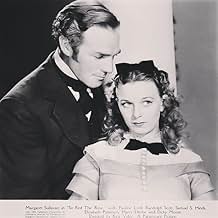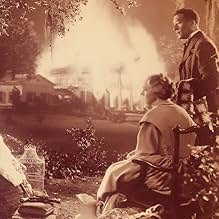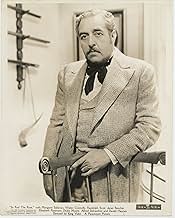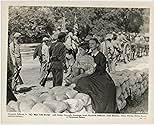"So Red the Rose" is King Vidor's quietly-affecting Civil War romance starring Margaret Sullavan as a Southern aristocrat, the mistress of a Southern plantation, whose sheltered life is torn... Read all"So Red the Rose" is King Vidor's quietly-affecting Civil War romance starring Margaret Sullavan as a Southern aristocrat, the mistress of a Southern plantation, whose sheltered life is torn apart by the War between the States. During the war's darkest days she is sustained by he... Read all"So Red the Rose" is King Vidor's quietly-affecting Civil War romance starring Margaret Sullavan as a Southern aristocrat, the mistress of a Southern plantation, whose sheltered life is torn apart by the War between the States. During the war's darkest days she is sustained by her love for a distant cousin, a Confederate officer played by Randolph Scott.
- Confederate Officer
- (uncredited)
- Cavalry Captain
- (uncredited)
- Slave
- (uncredited)
Featured reviews
The one moment that does stand out (and stands out against the normal racist rubbish of the 1930s) was when Sullivan confronts her slaves, who have heard the Yankee troops are approaching and they may be free. She tries to control them with reminders of how good her family was to them (although - tellingly - she slaps one who dare suggests its wasn't all that great). But further bad news reaches her, and she collapses. The slaves look at her - and walk away to desert the plantation. No scene like that is in GWTW, but I suspect it happened far more frequently than Margaret Mitchell would have preferred to have know of.
Strong performances from Margaret Sullavan, Walter Connolly, Elizabeth Patterson and especially Janet Beecher give the film a solid base - and Vidor's technical skill and Victor Milner's cinematography give the film beauty. But it is Vidor's humanism that gives it heart. He was a remarkable artist - much over-looked by film historians. "So Red the Rose" is not a great film, but it is a remarkable one.
The reason why Gone With The Wind enthralled so many people is that it both sustained interest for an almost four hour running time and created an incredible amount of interesting supporting characters, the movie and novel is definitely not just about the four leads. So Red The Rose never was able to do that and it's the difference between a reasonably good film and a screen classic.
The action centers around the Bedford family of Mississippi and it opens just before the firing on Fort Sumter. Walter Connolly is the head of the Bedford clan and wife Janet Beecher, daughter Margaret Sullavan, sons Harry Ellerbe and Dickie Moore. Ellerbe has a guest in Texas boy Robert Cummings. And there's distant cousin Randolph Scott, distant enough for Margaret Sullavan to get interested in. Remember the President and First Lady at the time also had the same last name and were fifth cousins before they married.
Scott's part is a combination of elements of both Rhett Butler and Ashley Wilkes. Like Butler he's reluctant to get involved in the war, but not for Butler's practical reasons. He has friends and relatives in the north and does not relish the idea of a Civil War like Wilkes. But later after the war hits home he rallies to the Confederacy.
The treatment of the slavery issue is what makes most people dislike So Red The Rose and Margaret Sullavan's scene where she talks the slaves into not rebelling and leaving the old plantation. Listen carefully to what she does say if you watch the film. She concedes absolutely that slavery is at an end, but when Sullavan argues and quite persuasively, you're free as soon as the Union Army arrives to enforce the Emancipation Proclamation, but free to do what? It's not like the promised land immediately arrives, freedom means that you are free to work for yourself or for wages. She raises issues that the USA was unable to grapple with during Reconstruction for a whole lot of reasons. In fact the plight of the slaves is dealt with more in So Red The Rose than in Gone With The Wind and better dealt with than in Birth Of A Nation.
In a recent book on Margaret Sullavan author Lawrence Quirk said that Sullavan at one time or another tried to get things going with Randolph Scott, Bob Cummings, Charles Starrett and Johnny Downs who were all in the cast. Rumors were flying so about what was happening off the set that Sullavan's then husband William Wyler asked his colleague King Vidor to step in to which Vidor politely and firmly decided he was not getting involved in any cast member's personal business. Sullavan could be difficult to work with.
She also was not crazy about Randolph Scott either as actor or the fact he declined her offers and maybe one influenced the other. Now Scott was not as good here as the Randy Scott we knew later on in his classic westerns, but as a Virginia born southerner he fit his role fine. Margaret decried his lack of historical knowledge, but from what I've heard about Randolph Scott his favorite reading was the financial page in the newspaper. He invested shrewdly and became one of the wealthiest actors in Hollywood.
So Red The Rose tanked at the box office leading cynical Paramount executives to call it So Red The Ink. The movie-going public just wasn't ready for a Civil War epic. But seen today it isn't as bad as its reputation would have it.
No, this movie isn't in Technicolor, there's no tearjerker theme, and the running time is half that of the famous epic, but it's still very similar. I'm not a Margaret Sullavan fan, but she's just fine in this role. Randolph Scott is, of course, perfect. Walter Connolly, a highly underrated actor with too brief a career, added to the believability of the film. If you love Gone With the Wind, I really wouldn't recommend renting this version. It won't change your mind, since it's obviously a lesser quality movie. But if you always feel frustrated every time you hear Clark Gable speak without a Southern accent, this movie will help vindicate you.
Did you know
- TriviaOne of over 700 Paramount Productions, filmed between 1929 and 194; its, which were sold to MCA/Universal in 1958 for television distribution, and have been owned and controlled by Universal ever since; its earliest documented telecast took place in Seattle Tuesday 24 March 1959 on KIRO (Channel 7); it first aired in Boston 6 December 1959 on WBZ (Channel 4).
- GoofsAt about 52 mins, a pickup truck can be seen driving slowly in the distance, followed by a horse-drawn vehicle.
- ConnectionsFeatured in Black Shadows on a Silver Screen (1975)
Details
- Runtime1 hour 22 minutes
- Color
- Aspect ratio
- 1.37 : 1
Contribute to this page





































